|
Mount Ayr Record-News
Mount Ayr, Ringgold County, Iowa
Thursday, March 17, 2016, Pages 1 & 10
4-H in Ringgold County: A history of youth education
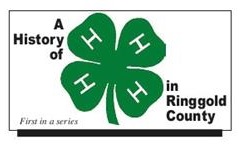
Editor's Note: The following series of five articles chronicling the history of 4-H in Ringgold County is reprinted by permission of the Iowa 4-H Foundation and can be found (with pictures) on the Foundation
website: https://www.iowa4hfoundation.org/
This first article covers the years 1918 through 1939.)
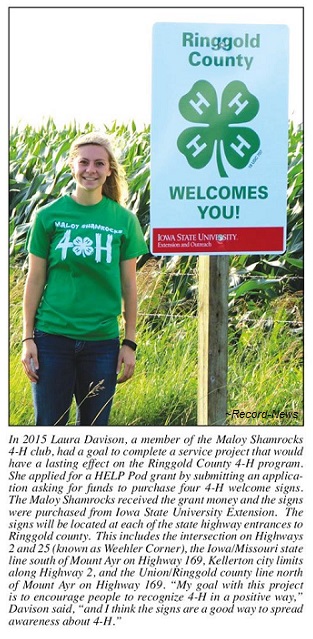 In 1918, youth education had a presence in the lives of children and families in Ringgold County. Children from Jefferson, Tingley, Union, Mount Ayr and Rice Townships were involved in Boys and Girls Clubs, a total of 215 youth.
Many of the children were in small, rural country schools not far from their home and families. The education received in the Boys and Girls Clubs were shared with their parents and other friends and family members.
The information allowed for “modern” ways to be put into practice as well as for children to be mentored by caring adults. There was a significant relationship between Extension and Farm Bureau in all efforts to have a
great youth program in the county.
In 1918, youth education had a presence in the lives of children and families in Ringgold County. Children from Jefferson, Tingley, Union, Mount Ayr and Rice Townships were involved in Boys and Girls Clubs, a total of 215 youth.
Many of the children were in small, rural country schools not far from their home and families. The education received in the Boys and Girls Clubs were shared with their parents and other friends and family members.
The information allowed for “modern” ways to be put into practice as well as for children to be mentored by caring adults. There was a significant relationship between Extension and Farm Bureau in all efforts to have a
great youth program in the county. Many 4-H Clubs began in 1923 in Grant Township in Ringgold County. Every child 10 years old or older could join. Mr. and Mrs. Vere Wallace went to Grant School No. 6 to talk to the
students about joining 4-H. The club continues today with the most recent names of the Jolly Jinglers and Crooked Creek 4-H Club. The projects consisted of art appreciation where every girl was given a packet of pictures
to study. Other emphasis was put on music appreciation, making a dressing table from 2 orange crates and a board, and painting a wooden clothes hanger decorated with stencils.
Conditions existing in Ringgold County in 1936 made the county agent devote a large amount of time to general organization work. There were no boys clubs in the county and only three girls clubs at the beginning of the year.
There were so few Farm Bureau members and no community Farm Bureau meeting was held making a direct method of approach nearly impossible. The Boys Club committee had been appointed but had not been active.
The girls’ club committee had only three members including the Home Project chairman ex officio. Roads, impassable because of snow and mud, made any amount of organization work impossible until late in March.
Several of the high schools of the county were closed during February due to coal shortages making it hard to start organization work through the schools. The first community contact was made at Kellerton School to the high
school students and a boys club and a girls club leader was secured. The organizational [Page 10] meeting was held in late March. Recreation was folk games and the county agent gave out information about club work
and officers were elected. The same method was used in strengthening 4-H in the communities of Redding, Delphos, Beaconsfield, and Tingley. The high school superintendents were helpful in every step along the way.
The need for leaders was daunting. Most adults were afraid to undertake the work because of inexperience. There were instances where modification of rules made it possible to carry on when strict adherence would have
meant no progress. The club committee and fair board made classification changes that made it possible for boys to carry projects as part owners and with grade livestock where it was impossible to do anything more
satisfactory. “Make the best of what you have” was the motto for the year. As a result, boys and girls had the advantage of club experience and training without expense to themselves except for their time and effort.
Ninety-five girls and 68 boys were examined in the health program. Thirteen local doctors and dentists cooperated in giving the exams. Children from the Kellerton Klimers, Peppy Poe, Delphos Daffodils, Redding Happy
Workers, Jolly Rovers, Flowery Glen Hustlers, Happy Hi-Way Club, Junior Maids of Tingley, Jolly Workers, Busy Maids of Beacon, Junior Farmers, Redding Club, Watterson Club, Riley Club, Kellerton Club, Delphos Club,
Lincoln-Jefferson Club, Tingley Club, and Beaconsfield Club participated in the contest. One boy and one girl represented Ringgold County as the top placed individuals and entered the State Health Contest and scored in
the red ribbon group. Some details about the early 4-H club “life” The Washington Workers Girls 4-H Club organized in March of 1936. There were 12 charter members. In the beginning,
all clubs of the county worked on the same project theme each year. Clothing, Food and Nutrition and Canning were alternated yearly with Home Improvement being added much later. The girls concentrated on being creative,
original, and practical in their club projects. The learning under excellent leadership made the club to be one of the most outstanding in Ringgold County. The Sunshine Workers history was first noted in 1939.
The leader felt that the outstanding accomplishment of the Sunshine Workers Club during the year was in music. They took an interest in the history of the operas and studied and enjoyed the contest. They were rewarded
at the county Rally Day be receiving the prize of next years Victrola records. All the members tried to attend club meetings even though they lived far apart and it was hard to get back and forth.
The Busy Maids of Beacon had a busy year and had excellent club spirit. It was reported that one girl gave up a trip to Colorado to be on the demonstration team and the two girls gave up their leisure time for six weeks to
work on the demonstration. Next week we will examine Ringgold County 4-H in the 1940s.
Mount Ayr Record-News
Mount Ayr, Ringgold County, Iowa
Thursday, March 24, 2016, Pages 1 & 10
4-H popular in Ringgold County during 1940s
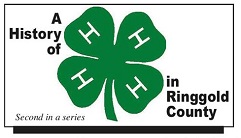
Editor's Note: This article is the second in a series of five articles chronicling the history of 4-H in Ringgold County is reprinted by permission of the Iowa 4-H Foundation and can be found (with pictures) on the Foundation
website: https://www.iowa4hfoundation.org/
This article covers the 1940s.)
4-H Camp The Ringgold-Taylor 4-H Camp was held at a church camp ground 4 miles west of Diagonal. The camp ground had a dining room and kitchen which had screened-in windows all around. Five cabins
with space for 20 girls in each were available for use. There was a light plant and a well with water that had been tested for purity. The water was hard and not very tasty. There were two outside pit toilets. Each girl that
attended camp furnished food and a cook was hired to provide meals. The original plan was to have five delegates from each club. Some of the clubs didn’t fill their quota so other clubs were allowed to send additional delegates.
There were a total of 70 delegates attending the camp from the two counties. Several leaders attended also. Each person paid $1.00 registration fee and a list of food to furnish. The registration fee was used to pay the
$12.50 rent for the camp grounds, handcraft materials, $5.00 for the cook, and food necessary to supplement what was brought. Foods purchased were milk, bread, meat, oranges, bananas, breakfast food and incidentals.
The camp was entirely self-supporting on the $1.00 registration fee and there was $5.00 left which was used for camp pictures to give to those attending camp.
In 1940’s, the Ringgold County colt club project was selected as the most outstanding and with the most members in the State of Iowa. Draft foals, yearlings and two-year-olds, and saddle foals and yearlings, and mules and
yearlings were exhibited. Awards were based on feeding and showing the colt, record book, showmanship, and horsemanship.
There were six hundred and thirty five mattresses were made in the Cotton Mattress program. These mattresses were made at 6 different centers supervised by hired people. One hundred thirty-two boys and girls were
enrolled in farm project clubs and 128 members completed the program. Fifteen townships were involved. There were boys clubs, girls clubs, beef clubs, pig clubs, colt club, purebred beef heifer and bull club, sheep
clubs, dairy clubs, poultry and corn clubs. The general objectives for 4-H Club Work included: 1. To bring about a finer type of rural life in Iowa. 2. To build up community activities for rural youth under the supervision
of volunteer local leaders. 3. To give training in local rural organization and leadership. 4. To develop and maintain increasingly higher standards in competitive and other club activities.
5. To teach approved farm and home practices. 6. To develop an attitude of placing welfare of the larger group above that of the smaller group or individual.
7. To make 4-H club work possible for every rural boy and girl of club age in Iowa. 8. To make the 4-H pledge a reality in the life of each 4-H member. 9. To dignify agriculture as a business. 10. To develop a program
for scientific measurement of the results of 4-H club activities. In 1942, the 4-H boys can girls club work was greatly affected by the war. They assisted with war bond drives, [Page 10] scrap drives and community activities.
Citizenship, health program, and learning by doing continued to be the principle measure used to sell 4-H to the public. The records indicated that the inability of club members to participate in club activities to the fullest extent
because of being drafted into the fields for longer hours and heavier work was the chief problem in carrying out 4-H club work this year. It was hard to keep up interest since local tours and judging workouts were held to a
minimum. Boys and girls club work and older youth would continue only if definite programs enlisted young people in vital production work. Suggested programs for 4-H club members would be to minimize project work
and enlist club members for active service in partnership with their parents. Service projects for rural youth would be directed toward morale building.
Mrs. Lloyd Davenport, 4-H Chairman, shared an interesting report regarding 4-H in 1942. Her remarks: “In 1942, the year when all America is organizing and getting into uniform we are proud and thankful that our rural girls
already have a great organization on duty and ready for what ever new tasks that might be assigned. In our county organized clubs did a fine job with oven products, notwithstanding the fact that many of the girls were called
upon to do extra farm work this year. This was the year too, when tire shortage was a bug-bear to committee women, leaders and girls alike. But I believe we are just beginning to see that as the transportation situation does become acute, we must look more and more to local communities for entertainment and recreation, so our 4-H clubs will be needed even more than ever and perhaps the very need will strengthen the clubs. I know of one club meeting where every member and leader walked at least one way. One club, newly organized last fall developed into a strong club during the course of the year. , though the beginning there were some doubt if there would be sufficient membership to carry on due to the annual March shift. Much of the success of this club, and of any club for that matter, was due to three important factors—eager girls who wanted a club very much; strong, capable leaders; and parents who were intensely interested in their girls and who gave their full cooperation to them in this effort. I’m wondering if we really give and show good leaders enough appreciation and recognition. With the dwindling away of membership of girls as soon as they are out of school as they go to college or away to work, there arises
the question of whether or not it would be practicable to give younger girls—of the ten to twelve age group. The greatest objection to the younger girls has always been that despite their enthusiasm, older girls do not want to
work with “mere infants”, but now that this group is apparently leaving us—at least for the duration, this objection, it seems, is removed. I think I cannot make a better closing statement than to quote from a 4-H girl, whom I
recently heard, say: “4-H is wonderful!” In the late 40’s there was a tremendous surge of in enrollment of both boys and girls in the county. The 4-H program was the best balanced all-around program in the history of 4-H
club work. The number of projects completed included 105 baby beeves; 25 purebred beef heifers, 35 market litters; 30 purebred litters; 136 ewes and lambs; 10 draft and saddle colts; over 2000 chicks and crop projects.
The recreational program included roller skating parties; a county-wide basketball tournament; county-wide 4-H party; county-wide club camp plus local club activities.
Thirteen boys clubs existed. The girls clubs centered on learning about home efficiency. There were 17 clubs with 205 girls involved. The girls enjoyed being a part of officer training; 4-H Mother-Daughter banquet; Rally
Day, 4-H Camp; State Convention, a health clinic; Achievement shows; county fun night; and skating parties. Joint activities for the boys and girls clubs came about in the late 1940’s.
Next week we will feature Ringgold County 4-H in the 1950s.
Mount Ayr Record-News
Mount Ayr, Ringgold County, Iowa
Thursday, March 31, 2016, Pages 1 & 9
County 4-H in 1950s included soil conservation efforts
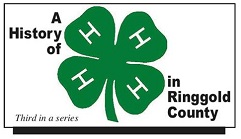
Editor's Note: This third article chronicling the history of 4-H in Ringgold County is reprinted by permission of the Iowa 4-H Foundation and can be found (with pictures) on the Foundation
website: https://www.iowa4hfoundation.org/
This article covers the 1950s.)
In the 1950’s the 4-H program gained additional education in the area of soil conservation.
Beaconsfield Experimental Farm was the ideal training ground to assist in bringing Iowa State University to the people. Livestock producers had better pastures and legume systems which allowed for more cattle production
and it was evident with increased numbers in 4-H Beef projects. Again, many county-wide joint activities were put in place to assist the youth to become better acquainted with there peers in the county as well as to learn
additional skills and techniques regarding their 4-H projects. The 4-H members did fundraising to be able to contribute $5 per club for the State 4-H Camp and that was deemed the most important activity of the year.
There were 17 girls clubs at the beginning of the decade and 16 boys clubs. “Preventing Little Pig Loss was a successful educational program in 4-H clubs.
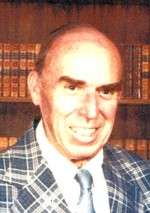 Milt Henderson, District Extension Youth Assistant, made a
tremendous difference in countless lives of youth in Ringgold County as well as in the rural area. Milt Henderson spent a lifetime loving youth and encouraging them to be the best possible persons they could become.
Milt Henderson, District Extension Youth Assistant, made a
tremendous difference in countless lives of youth in Ringgold County as well as in the rural area. Milt Henderson spent a lifetime loving youth and encouraging them to be the best possible persons they could become.
Milt became involved in ISU Extension work in 1946 and served on the local, area and state level. At one time Milt could name all the 4-H members in the six counties he served in southern Iowa. In addition to impacting so many
club programs, youth, and their volunteer leaders he served 25 years as swine superintendent at the Iowa State Fair, head of the State Fair Livestock and grain judging contests, dean of delegates at State 4-H Conference, head
of delegates at the American Royal 4-H Conference in Kansas City, organizer of the 4-H United Fund and of the 4-H Interstate Exchange program. Milt served the 4-H program and residents of Iowa until 1974 when health
matters caused him to resign from the youth work he so dearly loved. Milt Henderson's values, character, and role modeling has made a difference in several generations of Iowan's through his dedication to 4-H.
The local 4-H club leaders were praised for their involvement and general success of the program as they carried out their leadership roles. Activities included wiener roasts, hay rides, parties, demonstrations, fun night, farm
hazard check, county 4-H officers training school, joint soil conservation activities, 4-H skating parties, Christmas Rural Overseas program and rural life Sunday program. 4-H had definitely gained status in all the communities
in the county. The county local leaders and the 4-H committees fully appreciated the fact that the whole 4-H program worked toward the goal of providing good solid citizens for the communities of Ringgold County, state of Iowa,
the USA and the world. In 1953, up to 557 girls [Page 9] and boys were enrolled in 33 clubs in Ringgold County. Every 4-H member was to carry some type of farm or home project and was not considered a 4-H member
unless he does have a project. Club membership offered each boy or girl the opportunity to attend local club meetings once each month; to have a project that they themselves have constructed or cared for; take part in
a local club and county events such as judging teams, club tours, Rally Day, county trips and many other events; and to be eligible for county, state and national awards on the basis of their achievements in 4-H work.
Through these things it was hoped that the 4-H boy or girl of today would make a better citizen of tomorrow. The National 4-H Club Creed was integrated into Ringgold County 4-H. It was:
I believe in 4-H Club work for the opportunity it will give me to become a useful citizen.
I believe in the training of my HEAD for the power it will to give me to think, to plan, and to reason.
I believe in the training of my HEART for the nobleness it will give me to become kind, sympathetic, and true.
I believe in the training of my HANDS for the dignity it will give me to be helpful, useful and skillful.
I believe in the training of my HEALTH for the strength it will give me to enjoy life, to resist disease, and to work efficiently.
I believe in my country, my state, and my community, and in my responsibility for their development.
In all these things I believe, and I am willing to dedicate my efforts to their fulfillment.Ringgold County Educational Presentations at the Iowa State FairSome of the 4-H activities included program development,
enrollment meetings, boys annual meeting, girls annual meeting, 4-H Basketball Tournament, 4-H Market Swine Show, Boys 4-H Short Courses, 4-H Club Tours, 6-County Soil Conservation Field Day, 4-H Judging
Workouts, Record Book Training Sessions, boys/girls 4-H County Camp, Demonstration Contests, State Fair, St. Joseph Interstate Show, Leader-Training Meetings, State Camps, Mother Daughter Tea, Leadership
Training, Rally Day, Girls 4-H Convention, Demonstration Helps, Record Book Helps, County Fair, plus Food and Nutrition Judging Contests. A problem that was identified was leadership. “Leadership has been and is
now one of the serious problems as far as the total youth program is concerned in Ringgold County. Because of the fact that the county is strictly rural as far as job opportunities are concerned for young people, almost
100% of these people are leaving the county in search of jobs or for other reasons. Our older 4-H members who graduate out of local clubs very seldom stay in the county and establish themselves on the farm or in
business. Because of this, an additional hardship is created as far as good leadership is concerned.” Extension emerged as the overall governing body of 4-H in 1955 with Extension Council members providing guidance
and staff to meet the needs of the program. Next week we look at 4-H in the 60s and 70s.
Mount Ayr Record-News
Mount Ayr, Ringgold County, Iowa
Thursday, April 07, 2016, Pages 1 & 9
A look at local 4-H in the 1960s

Editor's Note: This fourth article chronicling the history of 4-H in Ringgold County is reprinted by permission of the Iowa 4-H Foundation and can be found (with pictures) on the Foundation
website: https://www.iowa4hfoundation.org/
This article covers the 60 and 70s.)
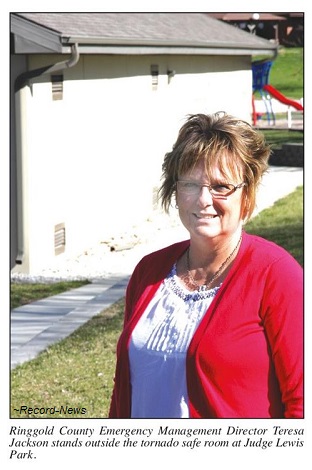 The 1960’s started with 18 girls clubs and 16 boys clubs under the direction of the Extension Council with assistance and support of the county 4-H boys and girls 4-H committees and leaders. Activities conducted on a joint
basis included Rural Life Sunday, 4-H Achievement Night, District Officers Training School, County Officers Training School, 4-H Skating Parties, Ringgold County Fair, Home Economics Judging Contests, Girls Demonstration
Contests, Boys Demonstration Contests, 4-H Leader-Committee Recognition Banquet, State 4-H Camp, Enrollment Meetings, Boys Annual Meetings, 4-H Basketball Tournaments, 4-H Market Swine Show, Boys 4-H Short
Course, 4-H Club Tours, 4-H Judging Workouts, Boys 4-H County Camp, Iowa State Fair, St. Joseph Interstate Show, Kansas City Royal, AK-SAR-BEN, Creston Swine Show, Winter Camp and Leader Training Meetings.
The 1960’s started with 18 girls clubs and 16 boys clubs under the direction of the Extension Council with assistance and support of the county 4-H boys and girls 4-H committees and leaders. Activities conducted on a joint
basis included Rural Life Sunday, 4-H Achievement Night, District Officers Training School, County Officers Training School, 4-H Skating Parties, Ringgold County Fair, Home Economics Judging Contests, Girls Demonstration
Contests, Boys Demonstration Contests, 4-H Leader-Committee Recognition Banquet, State 4-H Camp, Enrollment Meetings, Boys Annual Meetings, 4-H Basketball Tournaments, 4-H Market Swine Show, Boys 4-H Short
Course, 4-H Club Tours, 4-H Judging Workouts, Boys 4-H County Camp, Iowa State Fair, St. Joseph Interstate Show, Kansas City Royal, AK-SAR-BEN, Creston Swine Show, Winter Camp and Leader Training Meetings.
So many youth were involved in the basketball tournaments that they had to be divided into the Junior and Senior Basketball Tournaments. Ringadu Camp was established with Ringgold, Adams and Union County’s sending
delegates to camp [Page 9] where conservation and health were the identified priorities. There were plenty of opportunities for leadership development in the areas of recreation, as counselors, and cooking. Junior Day Camp
was also implemented with many of the activities and leadership methods used at Rinadu Camp scaled down and enjoyed by younger 4-H'ers. All 4-H’ers wore 4-H uniforms to school one day during 4-H Week. Many posters
and business windows had displays promoting 4-H. Some 4-H clubs had floats in parades to excite young people to about becoming involved in 4-H. Several 4-H’ers attended the Intermediate and Senior Midcrest Area Camp
at the State 4-H Camping Center near Madrid. A Farm Tractor Safety School assisted boys in learning and practicing safety while helping on the farm.
The 1970’s 4-H program was strong with extra emphasis placed on youth leadership development. Activities included the Beef Weigh-in, County Fair, County Fair Livestock Sale, Junior Day Camp, Annual County 4-H
Conference, Area Camps at the State 4-H Camping Center, Annual Leaders Recognition Banquet, Basketball Tournaments, Dairy and Swine Shows, State Fair, Farm Tractor Safety School, 4-H Sunday, Out-of-County Trip
Awards to the State 4-H Conference, Leadership Camp and Conservation Camp. A Meat Clinic was held at the ISU Campus. An Area Exchange Trip to Pennsylvania was held with Ringgold County 4-H’ers going East this
year after having Pennsylvania 4-H’ers in our County last year. In 1972, a new judging pavilion was built at the Ringgold County Fair Grounds with the older 4-H members and their leaders working to make the fair grounds
look its best. Junior 4-H camp was well attended. The participants prepared their own lunch wrapped in foil and cooked over a bed of coals. 4-H County Council, boys and girls, members were selected from each club.
The County Council members assisted in a variety of 4-H activities such as the award program and leader recognition banquet. 1972 was the first year the girls experienced the thrill of participating in the Junior 4-H Basketball
Tournament. The 4-H and Youth Committee was revised to include 5 youth to assist the 5 women and 5 men in making decisions that impacted and strengthened all the 4-H clubs in the county. A new building at the fairgrounds
was completed in time for county fair. It was termed “the girls” building. Four hundred sixty three exhibits were brought to the fair. One hundred and forty were Senior projects, 144 were Intermediate projects, and 179 Junior.
Next week we conclude this series by looking at 4-H in Ringgold County from the 1980s to the current day.
Mount Ayr Record-News
Mount Ayr, Ringgold County, Iowa
Thursday, April 14, 2016, Pages 1 & 10
Ringgold County 4-H has grown, still thriving

Editor's Note: This final article chronicling the history of 4-H in Ringgold County is reprinted by permission of the Iowa 4-H Foundation and can be found (with pictures) on the Foundation
website: https://www.iowa4hfoundation.org/index.cfm/36964/4842/ringgold_county_iowa_4h_history
This article covers the years 1980 to the present time.)
4-H School Enrichment was focused on during the 1980’s and 1990’s in addition to the multitude of projects available to 4-H members. Youth learned about substance abuse prevention and personal safety through puppet
shows and speakers from the Iowa State Highway Patrol. Other School Enrichment programs included food, food safety, art and leisure activities, and farm safety. 4-H County Council was strengthened with an emphasis
on planning and carrying out county activities and events such as school enrichment. Leadership development was promoted with youth and adult volunteers.
4-H County Council sponsored the basketball events, 4-H officer training, day camps, award program, Jr. Day Camp, Leader Banquet, basketball tournaments and strengthened 4-H in their home communities and clubs.
The growth and personal development that occurred assists them in all that they do as adults today. The 4-H Club name often time identified the club as one with an emphasis more specifically for males or females. All the
Clubs reviewed if they or their name was discriminatory. Several clubs made name changes to better reflect their work and membership and to be inclusive. Many youth enjoyed 4-H Camp at the 4-H Camping Center near
Madrid. Several County Council members and older teens served as camp counselors. It was a fun and learning centered week away from home where social and personal skills were learned and practiced. Ringgold County
youth attended State 4-H Conference in Ames. Many 4-H members have been honored for their club work, projects, and citizenship activities. The 4-H Clubs have beautified the local highways, held fundraisers for
families in need, adopted families for Christmas, went caroling, provided Easter egg hunts, provided parties for the mentally and physically challenged, improved the fairgrounds, volunteered at nursing homes and created parks.
The list is endless and the sustainability still exists. National and state awards have been awarded to Shirley Goins, Jim Smith, Vanette Hunt, Bobbi Hunt, Billi Hunt, Doug Hickman, Emily McAlexander, and Twin River
Tornadoes 4-H Club to name a few. Serving on State 4-H Council were Shirley Goins, Peter Hayse, Vanette Hunt, Lesa Stephens, Bobbie Hunt, Billi Hunt, Elsa McAlexander, Marci Miller, Landi McFarland and Amy Hynek.
Dr. Peggy Whitson (Astronaut) joined Ringgold County 4-H in 1970 and pursued her love of science through working [Page 10] at NASA and serving on the International Space Station twice.
Iowa House Representative Cecil Dolcheck was a Ringgold County 4-H member, leader, and fair superintendent. Vanette Hunt Grover authored a 4-H curriculum that is used world wide. Numerous 4-H members have made a difference in Ringgold County as 4-H members as well as continue giving back as adults to make our world a better place. 4-H has assisted greatly in defining who they became and how they are contributing to society. It is impossible to describe all the accomplishments and to identify everyone who needs recognized, however that does not make the accomplishments any less noteworthy.
In the 2000’s, the 4-H program continued to strive to provide more opportunities for the youth of Ringgold County. Day camps were offered during the summer months, a shooting sports program was initiated, continued participation in out-of-county activities (Iowa 4-H Conference, Regional 4-H Camp, Iowa State Fair, Ak-Sar-Ben, etc); a county Clover Kids program was established for youth kindergarten thru 3rd. 4-H County Council continued to show leadership skills in planning various county fair activities (mud volleyball tournament, future 4-H’er pet show, pancake breakfast, youth games/activities, livestock shows, etc), 4-H club vs club basketball tournament, youth overnighters, 4-H Awards program; exhibited their citizenship in building a community “Pop Can Shed” with the monies raised going towards community service projects (purchasing a gazebo for a local park, participating in the adopt-a-family at Christmas, landscaping at a local park, etc).
The 2010’s brought about the desire to focus on making improvements to the fairgrounds. It started with a volunteer group securing funds to build a beef project grooming facility, then one of our 4-H clubs created a children’s garden, another club built and donated barn quilts that were displayed at the fairgrounds, another club created new wash racks for the swine and sheep, and the Fair Boards started work to make improvements to the 4-H Exhibit Building (new bathrooms, air-conditioned, etc) and show arena. 4-H participation has continued to increase each year over the past 3 years, so the efforts to retain those youth continue on.
Visit the Ringgold County 4-H website.
Photographs courtesy of Mount Ayr Record-News
Transcription by Sharon R. Becker, August of 2016


|